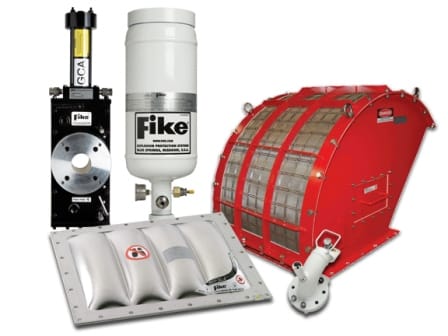Dust Collector Explosion Protection Dust collectors may be protected with “passive” or “active” systems depending on several factors such as the location of the equipment, the dust explosion characteristics, lower total cost of ownership, and more. Passive explosion protection systems react to a deflagration’s pressure, while active explosion protection includes electronic detection and control which activates connected systems within milliseconds of detection. Passive Protection for Dirty Air Plenum: Explosion vents are used to relieve pressure and flame in a controlled manner to keep the explosion pressure below the equipment strength. A vent duct may be used to direct the explosion to a safe area, or a flameless venting device may be placed on top of the vent panel to extinguish explosion flames but allow pressure to pass through. In Clean air Outlet: When rupture of filter bags cannot be prevented and the flame and pressure cannot be directed to a safe area, or when the process fan must be protected, explosion isolation is required. A VENTEX isolation valve is a spring-loaded poppet which will lock and prevent pressure and flames from reaching downstream equipment. Dirty Air Outlet: The explosion pressure generated in the dust collector will reverse the airflow in the dirty air inlet causing explosion propagation toward upstream equipment. A passive mechanical valve (Fike DFI) is a reliable and cost-effective method for explosion isolation. The deflagration’s pressure closes the DFI’s dual flaps into a locked position, protecting upstream equipment from pressure and flames. Product outlet: May be protected by a rotary valve or double valve system if certified for explosion isolation use. If not, a minimum product fill level may act as a product choke during an explosion. If explosion propagation cannot be prevented, a chemical barrier (Fike SRD) can be used. We also have Active Protection for a dust collector. For more details contact us.

This is your website preview.
Currently it only shows your basic business info. Start adding relevant business details such as description, images and products or services to gain your customers attention by using Boost 360 android app / iOS App / web portal.
Dust Collector Explosion Protection Dust colle...

2023-05-20T08:15:21
Dust Collector Explosion Protection Dust collectors may be protected with “passive” or “active” systems depending on several factors such as the location of the equipment, the dust explosion characteristics, lower total cost of ownership, and more. Passive explosion protection systems react to a deflagration’s pressure, while active explosion protection includes electronic detection and control which activates connected systems within milliseconds of detection. Passive Protection for Dirty Air Plenum: Explosion vents are used to relieve pressure and flame in a controlled manner to keep the explosion pressure below the equipment strength. A vent duct may be used to direct the explosion to a safe area, or a flameless venting device may be placed on top of the vent panel to extinguish explosion flames but allow pressure to pass through. In Clean air Outlet: When rupture of filter bags cannot be prevented and the flame and pressure cannot be directed to a safe area, or when the process fan must be protected, explosion isolation is required. A VENTEX isolation valve is a spring-loaded poppet which will lock and prevent pressure and flames from reaching downstream equipment. Dirty Air Outlet: The explosion pressure generated in the dust collector will reverse the airflow in the dirty air inlet causing explosion propagation toward upstream equipment. A passive mechanical valve (Fike DFI) is a reliable and cost-effective method for explosion isolation. The deflagration’s pressure closes the DFI’s dual flaps into a locked position, protecting upstream equipment from pressure and flames. Product outlet: May be protected by a rotary valve or double valve system if certified for explosion isolation use. If not, a minimum product fill level may act as a product choke during an explosion. If explosion propagation cannot be prevented, a chemical barrier (Fike SRD) can be used. We also have Active Protection for a dust collector. For more details contact us.
2023-05-20T08:15:21
Keywords
- top
- details
- airflow
- rupture
- reliable
- Fike DFI
- location
- Fike SRD
- ownership
- safe area
- vent duct
- vent panel
- dual flaps
- process fan
- filter bags
- rotary valve
- milliseconds
- deflagration
- product choke
- Product outlet
- active” systems
- dirty air inlet
- locked position
- Dust collectors
- Explosion vents
- several factors
- chemical barrier
- Dirty Air Plenum
- lower total cost
- Dirty Air Outlet
- Clean air Outlet
- explosion flames
- controlled manner
- connected systems
- Active Protection
- Passive Protection
- equipment strength
- explosion pressure
- upstream equipment
- double valve system
- downstream equipment
- electronic detection
- spring-loaded poppet
- cost-effective method
- explosion propagation
- explosion isolation use
- A VENTEX isolation valve
- passive mechanical valve
- flameless venting device
- minimum product fill level
- active explosion protection
- dust explosion characteristics
- Dust Collector Explosion Protection
- Passive explosion protection systems

Submit Your Enquiry